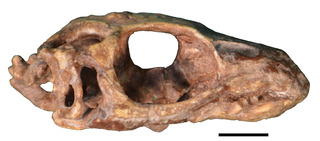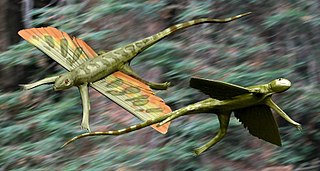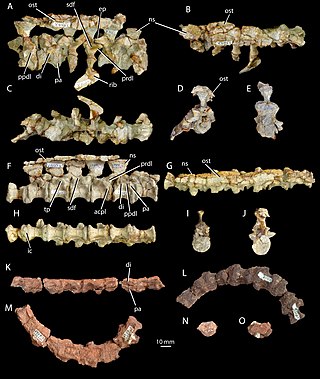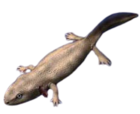
The Lissamphibia is a group of tetrapods that includes all modern amphibians. Lissamphibians consist of three living groups: the Salientia, the Caudata, and the Gymnophiona.

Triadobatrachus is an extinct genus of salientian frog-like amphibians, including only one known species, Triadobatrachus massinoti. It is the oldest member of the frog lineage known, and an excellent example of a transitional fossil. It lived during the Early Triassic about 250 million years ago, in what is now Madagascar.

The Museum of Evolution of Polish Academy of Sciences is the display area of the natural history museum in Warsaw, Poland. It is the public front of the Muzeum i Instytut Zoologii or Zoology Museum and the Instytut Paleobiologii or Paleobiology Institute. It is based at the Palace of Culture and Science.

Osmolskina is a genus of archosauriform reptile which lived during the Early Triassic in what is now Poland. The type species, Osmolskina czatkowicensis, was described by Magdalena Borsuk−Białynicka and Susan Evans in 2003. The generic name honors the late female Polish paleontologist Halszka Osmólska.

Eolacertilia is an extinct clade of lepidosauriform diapsid reptiles known from the Late Permian to the Late Triassic. It is uncertain as to whether they are a natural group and it has been suggested that they form a "waste basket" taxon. Currently, the only members of the group are Paliguana and Kuehneosauridae. Other genera were transferred to basal groups within Diapsida, Archosauromorpha.

Paleontology or palaeontology is the study of prehistoric life forms on Earth through the examination of plant and animal fossils. This includes the study of body fossils, tracks (ichnites), burrows, cast-off parts, fossilised feces (coprolites), palynomorphs and chemical residues. Because humans have encountered fossils for millennia, paleontology has a long history both before and after becoming formalized as a science. This article records significant discoveries and events related to paleontology that occurred or were published in the year 2009.

Kuehneosauridae is an extinct family of small, lizard-like gliding diapsids known from the Triassic period of Europe and North America.
Jaikosuchus is an extinct genus of proterosuchid archosauriform. It contains a single species, J. magnus. Fossils have been found from European Russia that date back to the upper Olenekian stage of the Early Triassic.

The Salientia are a total group of amphibians that includes the order Anura, the frogs and toads, and various extinct proto-frogs that are more closely related to the frogs than they are to the Urodela, the salamanders and newts. The oldest fossil "proto-frog" appeared in the early Triassic of Madagascar, but molecular clock dating suggests their origins may extend further back to the Permian, 265 million years ago.
Dorosuchus is an extinct genus of archosauriform previously assigned to the family Euparkeriidae. It lived during the Anisian stage of the Middle Triassic. Fossil material is known from Sol-Iletsk in Orenburg Oblast, Russia. The type species is D. neoetus, named in 1989.
Procolina is an extinct genus of procolophonid parareptile known from partial remains found in Early Triassic rocks of Czatkowice 1, Poland. It was first named by Magdalena Borsuk−Białynicka; and Mariusz Lubka in 2009 and the type species is Procolina teresae

Sophineta is an extinct genus of basal lepidosauromorph reptile known from the Early Triassic of Małopolska Province, southern Poland. It contains a single species, Sophineta cracoviensis.
Collilongus is an extinct genus of small archosauriform, possibly a rauisuchian, known from Early Triassic rocks of Czatkowice 1, Poland. It was first named by Magdalena Borsuk−Białynicka; and Andriej G. Sennikov in 2009. The type and only known species is Collilongus rarus. It is a rare component of the Czatkowice 1 fauna, known only from vertebrae. Collilongus was a contemporary of the more common archosauriform Osmolskina.
Czatkowiella is an extinct genus of long-necked archosauromorph known from Early Triassic rocks of Czatkowice 1, Poland. It was first named by Magdalena Borsuk−Białynicka and Susan E. Evans in 2009 and the type species is Czatkowiella harae.
Susan Elizabeth Evans is a British palaeontologist and herpetologist. She is the author or co-author of over 100 peer-reviewed papers and book chapters.
Meyerosuchus is an extinct genus of mastodonsauroidean temnospondyl. Fossils have been found from the Early Triassic Hardegsen Formation in southern Germany. Meyerosuchus is present in late Olenekian deposits of the Middle Buntsandstein. The type species M. fuerstenberganus was named in 1966, although remains have been known since 1855. Meyerosuchus is closely related to Stenotosaurus; both genera are grouped in the family Stenotosauridae and the two genera may even be synonymous.

Halazhaisuchus is an extinct genus of archosauriform from the Early Triassic of China. It is known from a single species, Halazhaisuchus qiaoensis, which was named in 1982 from the lower Ermaying Formation in Shaanxi. It was assigned to the family Euparkeriidae as a close relative of the genus Euparkeria from South Africa. Halazhaisuchus is known from a single holotype specimen called V6027, which was discovered in 1977 and includes a portion of the vertebral column, some ribs, two scapulae and two humeri, the right radius and ulna, and a left coracoid. Two rows of plate-like bones called osteoderms run along the length of the vertebrae. When it was first described in 1982, Halazhaisuchus was considered a close relative of Euparkeria because it has primitive features like small intercentra bones between the vertebrae and a large coracoid, not seen in later archosaurs. However, these features are common to many early archosauriforms and are not unique to Euparkeriidae.

Marmoretta is an extinct genus of small lepidosauromorph reptile known from the Middle Jurassic (Bathonian) of Britain, as well as the Late Jurassic of Portugal. It contains a single species, Marmoretta oxoniensis.
Pleurodontagama is an extinct genus of iguanian lizard from the Late Cretaceous of Mongolia. The type species, Pleurodontagama aenigmatodes, was named in 1984 on the basis of a mostly complete skull and isolated lower jaw from a fossil locality called Khermeen Tsav. It has a wide skull with a flat snout, large eye sockets, and small bumps on the surfaces of the bones. Pleurodontagama was initially classified in the family Priscagamidae, which is usually grouped in a large clade of iguanians called Acrodonta, members of which are characterized by an "acrodont" dentition in which the teeth grow from the margins of the jaws. However, Pleurodontagama is unusual in that it has a sub-pleurodont dentition, meaning that some of its teeth grow from the inner surfaces of the jaw. There is also evidence to suggest that its teeth may have been continuously replaced throughout life, as opposed to the permanent teeth of acrodontans. Pleurodontagama may have been a transitional form between the derived acrodont type and the pleurodont type inferred for the ancestors of Acrodonta.
Maria Magdalena Borsuk-Białynicka is a Polish paleontologist and phylogeneticist born in 1940 in Warsaw, Poland. She received both her Master of Science and Doctor of Philosophy degrees in Warsaw University, before completing her Doctor of Science at Jagiellonian University. In 2001 she became an official Professor in Paleontology. Borsuk-Białynicka has taught alternately at Warsaw University and University of Adam Mickiewicz, while also supervising MSc and PhD students at both universities and the Silesian University. Her current (2017) PhD students are Marec Dek, Piotr Skrzycki and Dawid Surmik, who specialize in agnathan fishes, Triassic lungfish and Triassic marine reptiles respectively. Borsuk-Białynicka was a co-editor of the journal Palaeontologia Polonica volume 65 in 2009, and an assistant editor for the monographs in the journal from 1990 to 1997. Borsuk-Białynicka has named the sauropod Opisthocoelicaudia in 1977, the pelobatid frog Eopelobates leptocolaptus in 1978, the lacertoids Globaura and Eoxanta in 1988, the gekkonid Gobekko in 1990, and the archosauromorph Osmolskina in 2009.















